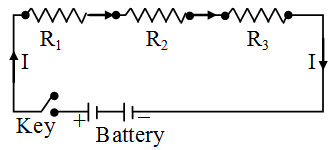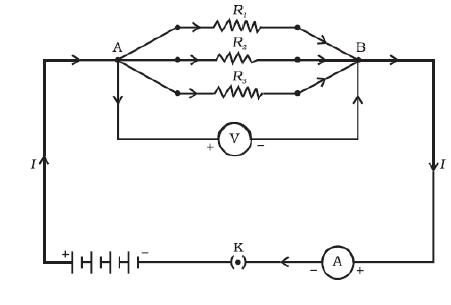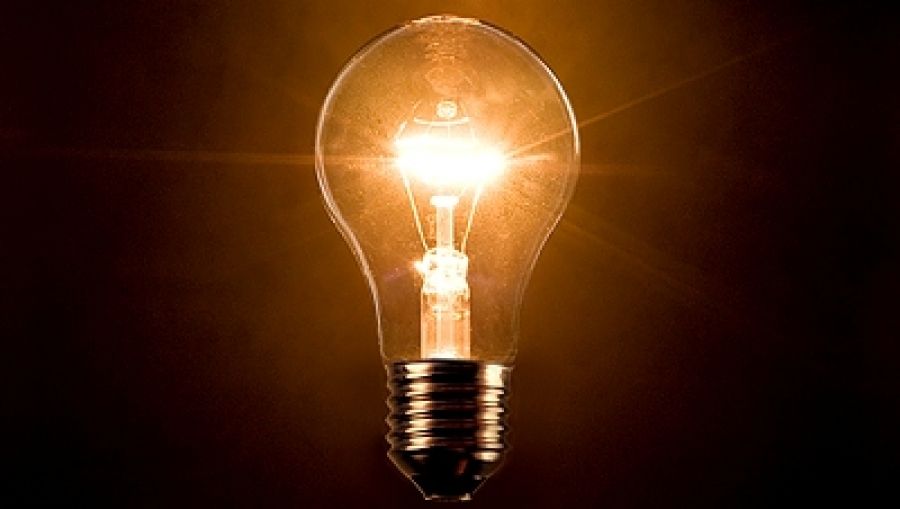Resistance:

- Resistance is the property of a conductor by which it opposes the flow of electric current through it.
R = \(\frac{V}{I}\)
- The SI unit of Resistance is ohm (Ω).
- 1 ohm is the resistance when potential difference across conductor is 1 V and the current through it is 1 ampere.
- The electrical appliance which is used to oppose the current flow in a circuit is called resistor.
- Variable resistance (Rheostat) is the component used to regulate current (electricity) without changing the voltage source.
Factors affecting resistance:
Factors on which the resistance of a conductor depends are:
- Length of conductor (R ∝ l)
- Area of cross section (R ∝ \(\frac{1}{A}\) )
- Nature of material
- Temperature
Resistivity:
- Resistance of a uniform metallic conductor is directly proportional to its length (l) and inversely proportional to the area of cross-section (A).
- R ∝ l
R ∝ \(\frac{1}{A}\)
Thus,
R ∝ \(\frac{1}{A}\)
R = ρ \(\frac{l}{A}\)
- Here, ρ (rho) is a constant of proportionality and is called the electrical resistivity.
- The SI unit of resistivity is Ω m.
- Resistivity is characteristic property of the material.
- Resistance, as well as resistivity both, varies with change in temperature.
Resistivity chart:
| Elements |
Conductivity |
Resistivity range |
| Metals and alloys |
Good conductors |
10–8 Ω m to 10–6 Ω m. |
| Rubber, glass |
Insulators |
1012 Ω m to 1017 Ω m. |
Combination of resistors:
There are two systems of combination of resistors. They are:
- Series combination
- Parallel combination
Resistance in series:

- When two or more resistors is joined end to end between two given points in a circuit, then these combination is said to be in series combination.
- Same current flows throughout the circuit i.e. same current flows through each resistor.
- Potential difference will be the sum of individual potential differences across each resistors.
- Ohm’s law can be applied to the combination to get equivalent resistance.
Equivalent resistance (Rs) in series combination:
V = V1 + V2 + V3
Now, we apply Ohm’s law:
iRs = iR1 + iR2 + iR3
Rs = R1 + R2 + R3
- We conclude that equivalent resistance in series combination is obtained by adding each individual resistance.
- Equivalent resistance is always greater than each individual resistance in series combination.
Resistance in Parallel:

- When ends of two or more resistors are joined to the two given point in a circuit, then these combination is called parallel combination.
- Potential difference between the two points across resistors are same.
- There will be different current flowing through each resistors.
Equivalent resistance (Rp) in series combination:
I = I1 + I2 + I3
By applying Ohm’s law:
\(\frac{V}{R_P}\) = \(\frac{V}{R_1}\) + \(\frac{V}{R_2}\) + \(\frac{V}{R_3}\)
\(\frac{1}{R_P}\) = \(\frac{1}{R_1}\) + \(\frac{1}{R_2}\) + \(\frac{1}{R_3}\)
- Thus, equivalent resistance across parallel combination of resistors is the sum of reciprocal of each individual resistance.
- The equivalent resistance of resistors in parallel combination is always less then the individual resistances.
Advantage of Parallel combination:

- In series combination a low and a high resistance can’t work properly, as current in series is same throughout. But current needed in each resistor is different. Whereas in parallel combination they work properly.
- In series combination, when one component fails the circuit is broken and none of the components works on the other hand there is no effect of failure of one component on other in parallel combination.
Heating Effect of Electric Current:

- If electric circuit is purely resistive then energy continually gets dissipated entirely in the form of heat. This is said to be heating effect of electric current.
- If I is current, R is resistance, V is potential difference, then work done in moving the charge Q through a potential difference V is VQ.
- The rate of consumption or dissipation of energy in an electric circuit is called electric power.
- Power = \(\frac{work \:done}{time}\) = \(\frac{VQ}{t}\) = V\(\frac{Q}{t}\) = VI
- Energy supplied to the circuit in time t = P x t = Heat produced
Thus, Heat produced (H) = VIt = I2Rt
Joule’s law of heating:
According to Joule’s law of heating:
- For a given resistance, the heat produced in a resistor is directly proportional to the square of current.
e. H ∝ i2
- For a given current, the heat produced in a resistor is directly proportional to resistance.
e. H ∝ R
- The heat produced directly proportional to the time for which the current flows through the resistor.
e. H ∝ t
Electric bulb:

- This is said to be the best discovery which uses electricity.
- The filament of electric bulb is made up of tungsten.
- Tungsten has very high melting point (3380⁰C).
- The bulbs are usually filled with chemically inactive nitrogen and argon gases to prolong the life of filament.
Electric power:
- The rate at which electrical energy is consumed or dissipated in an electric circuit is known as electric power.
P = VI = I2R = V2/R
- The SI unit of electric power is watt (W).
- 1 watt is the power consumed by an appliance that carries 1 A of current when operated at a potential difference of 1 V.
1 W = 1 volt × 1 ampere = 1 V A
- On large scale we measure electricity or electric power as kilowatt (1000 watt). Energy is counted in P x t so the unit we use to measure energy consumption commercially in KW h.